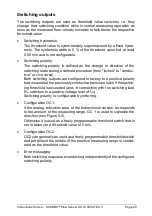
Instructions for Use
– SCHMIDT
®
Flow Sensor SS 23.400 ATEX 3
Page 17
If the maximum current is almost reached, the emitter resistance gen-
erates an inverse feedback holding the current I
S
virtually constant
while the voltage drop over the switching transistor (from U
OC
≈ 2.6 V)
rises significantly (analog current limiting).
Regarding this borderline case, the minimum allowed (static) load re-
sistance R
L,min
at an actually active switching voltage U
S
can be calcu-
lated
13
:
𝑅
𝐿,𝑚𝑖𝑛
=
𝑈
𝑆
− 2.6 𝑉
0.05 𝐴
Example:
At switching voltage of U
S,max
= 26.4 V is R
L,min
= 476
.
If the load resistance is too low (e.g. a short circuit), a digital short-
circuit protection comes in effect. It switches the output on and off (im-
pulse length of switch through is approx. 1 ms, switch-off break approx.
300 ms) until the cause of the faulty switching is eliminated.
An inrush current due to a high capacitive load can trigger the
quick-reacting short-circuit protection (permanent) although
the static current requirement would be below the maximum
current I
S,max
.
An additional resistance connected in series to the load ca-
pacity can eliminate the problem.
Each switching output is protected against voltage peaks by an uni-
polar TVS diode
14
. Positive voltage impulses, e.g. due to ESD sparks
or an inductive load, are limited to approx. 30 V at the connecting pin,
negative impulses are short-circuited against GND (conducting-state
voltage of a diode).
13
The basic current of the switching transistor is negligible.
14
Transient Voltage Suppressor Diode











































